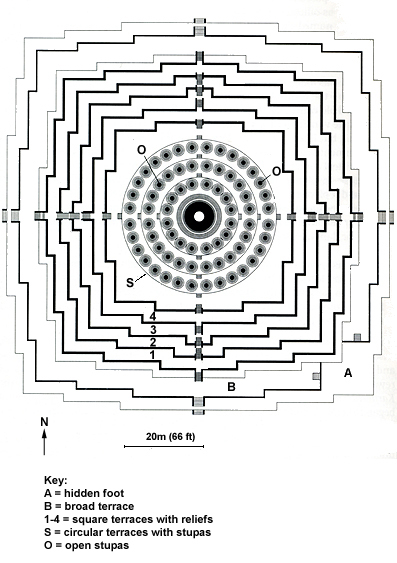The jatakas and avadanas are popular stories about the past lives (incarnations) of human beings like Shakyamuni, who eventually became bodhisattvas as the result of their selfless actions. The life of Shakyamuni, on the upper tier of corridor 1, is taken from an Indonesian version of the Lalitavistara Sutra, that describes his birth, spiritual journey, and enlightenment. The Gandavyuha Sutra (the last chapter of the Avatamsaka Sutra) is the story of a pilgrim named Sudhana, who visited 54 teachers1 in the course of a spiritual quest. All of these reliefs, in other words, are teaching aids that instruct visitors in how to become a bodhisattva, the spiritual goal of Mahayana Buddhist practice.
After circumambulating the teaching corridors with their pictorial reliefs, the pilgrim ascends to the open upper platform that is occupied by 72 buddha statues ("S" in the diagram), each displaying dharmachakra mudra and enclosed in its own small, pierced, stupa. (The number 72 again has numerological significance, being the product of 9x8 = 3x3x2x2x2 = two threes times three twos.) Two of these small stupas have been opened ("O" in the diagram) for display to modern visitors. Many scholars believe that this level represents the Buddhist Realm Of Formlessness (i.e. the spiritual world), a higher reality in contrast to the Realm Of Form (i.e. the physical world) that is depicted in the corridor reliefs. The entire plan, with its square and circular elements, can also be interpreted as a physical mandala through which the pilgrim may navigate in order to further his spiritual growth.
The large central stupa that crowns the monument has a hollow chamber within, that is completely walled off from the outside. When opened during restoration, it was found to contain an unfinished Buddha image that may represent a transcendent spiritual state. Besides these interpretations, the monument as a whole with its overall form and various levels and decorations can be seen both as a symbolic stupa, and as a world-mountain. All of these symbolic meanings are compatible with each other, and probably all were intended to apply here. Such multivalent symbolism was culturally available and readily understood both to the builders of the monument and to those who utilized it in their religious activities. This large and magnificent work can also be seen, in secular terms, as a most impressive demonstration of the power and piety of the Sailendra kings who organized and financed its construction.
The measurements of the monument are given by Soediman (in "Borobudur Cultural Heritage," Studies in Conservation, Vol. 18, No. 3, August 1973, pp. 102-112) as 123m (400 ft) each side, by 31m (100 ft) high.
1J. W. Heisig, Way of Enlightenment, Way of Salvation, Studies In Interreligious Dialogue 14 (2004), p. 57. Fifty four is half of 108. Most commentators quote a figure of fifty two teachers, omitting to count Maitreya and Samantabhadra.

|

|

|
